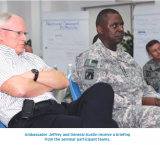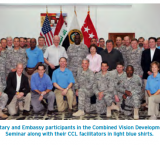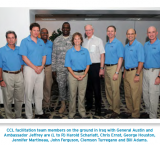Story:
Boundary Spanning Leadership - Operation New Dawn, Iraq, Circa 2010
Our relationship with others is often determined by boundaries found in virtually all organizations: demographic, geographic, horizontal, vertical or stakeholder. All too often, however, boundaries become barriers separating people into groups of “Us” and “Them.” These shared identities can create suspicion and distrust that undermine effective collaboration.
Yet in today’s interdependent and complex world, effective solutions to the most pressing challenges in business, government and our global society involve working together collaboratively. We must find a way to work with other groups despite differences in our defining values, perspectives and beliefs. Leaders must learn to span boundaries.
So how does one become a boundary-spanning leader? What does it “look like” when people behave interdependently across the boundaries of their differences? What kind of leadership encourages and enables diverse parties to behave collaboratively? What does it take to move from “US versus THEM” to “WE are in this TOGETHER”?
The story of General Austin, Ambassador Jeffrey and the joint mission in Iraq between the Department of Defense and the Department of State helps to answer these questions.
On September 1, 2010, Lloyd J. Austin, III became Commanding General of U.S. Forces-Iraq (USF-I). Just days before, James F. Jeffrey was confirmed as the new U.S. Ambassador to Iraq.
The United States had just completed Operation Iraqi Freedom which ceased combat operations and reduced U.S. troops in Iraq from a high of 115,000 to 50,000.
Together, General Austin and Ambassador Jeffrey were now charged with leading Operation New Dawn and the United States’ transition from a military operation to a sustainable diplomatic and civilian role in Iraq. They had fifteen months to accomplish the mission including the withdrawal of all U.S. forces.
If you follow news reports, you know the outline of events in Iraq. What you don’t know is the story of a leadership relationship characterized by an extraordinary commitment to working across boundaries – and how it applies to you.
For 43 years, the Center for Creative Leadership has dedicated itself to the research and teaching of leadership across the world. True to it's mission from its inceptions - 'to advance the understanding, practice and development of leadership for the benefit of society worldwide', The Center has graduated over half a million leaders through its programs. This story is about a program that's among the ones that the Center is the proudest of!
Imagine the boundary spanning challenges as the U.S. role in Iraq transitioned from the Department of Defense to the Department of State.
Two organizations with vastly different cultures had to complete a delicate handoff in just 15 months prior to the departure of the U.S. military in December 2011. They needed to work together with a myriad of American, Iraqi and regional players to forge a secure, self-reliant and sovereign nation.
“We’re in uncharted waters,” said General Austin of Operation New Dawn, the name of the Iraqi campaign after September 1, 2010. “We’re drawing down a significant military footprint after eight years of combat, moving a mountain of equipment, transferring responsibilities and equipment to the State Department, negotiating with the Iraqi leadership about the future, and helping to shape things in this region.”
It was clear to both General Austin and Ambassador Jeffrey that the complex, high-stakes nature of their task and the many groups involved required the two organizations to transform into a “team of teams.”
General Austin explained: “Partnership with the Embassy was one of, if not my top priority, coming into this job. The partnership was pretty good over the years leading up to this, but knew we had to make it better going into the final lap. I felt that one of the things I had to do early on was establish a great relationship with the Ambassador. Luckily, Jim Jeffrey was of like mind. We both felt that unity of effort needed to start at the top.”
Both men also knew that the relationship needed to be woven deep and wide through the two organizations as they worked together on common goals. Navigating horizontal boundaries – or those that span functions, peers and expertise – between the Departments of Defense and State was crucial. General
Austin continued: “I knew we had to build a team of teams with the Ambassador and the Embassy. If we achieved unity of effort, we would have a chance to reach all of our objectives. We really thought about this, and we felt that if we worked at cross-purposes, it would be nearly impossible to accomplish both of our mission sets.”
Ambassador Jeffrey concurred: “We were faced with what I would call a ‘no-kidding, ultra-hard mission’. And if you’re faced with a no-kidding, ultra-hard mission, you really have to scrub down to the basic things that make your institution or the set of institutions really, really good. Unless you’re lucky or really, really good, your chances of success are very small … In our particular case, it’s not just one organization. It’s two or more working together. And therefore, the nodes between them, the things that link them together, those have to be carefully looked at to ensure that they are working well and that they are complementing and reinforcing what we’re trying to do. You’re going to have enough external problems tackling an ultra-hard problem to generate internal stresses and strains and frictions.”
General Austin and Ambassador Jeffrey knew that their complex mission demanded a tight, “as one” working relationship among individuals and teams throughout both organizations. But wisely, they did not assume that their people knew how to span longstanding boundaries to collaborate effectively.
The two leaders understood that it would take more than assigning people to work together on tasks or talking the talk of collaboration. Just putting groups together when there is a history of competition or conflict or “different DNA” typically leads to failed partnerships, diminished problem-solving capability, turf battles, disengagement and distrust, and decreased productivity.
The General and the Ambassador decided to build capacity for collaboration within their organizations by conducting a “Combined Vision Development Seminar” for the senior Division Commanders, General Officers and
Counselor-level Embassy personnel. The goal of the seminar – a one-day session held in Baghdad just weeks after the two men had assumed their respective posts – was to jump-start the process of becoming a “team of teams.” The day would set the framework for “how” the two departments were going to achieve unity of effort.
During the seminar, the participants from Defense and State learned about three strategies that would allow them to effectively overcome the challenges of identity difference, span boundaries and create high-performing, collaborative teams:
Manage boundaries.
The first step to spanning boundaries, ironically, is to create or strengthen them. You must be able to see group boundaries clearly before you can bridge them. It taps into the power of differentiation (e.g., clarifying roles, purpose, areas of specialization) in order to build safety and respect across boundaries.
Forge common ground.
Common ground represents what is universal and shared. To forge common ground is to bring groups together to achieve a larger purpose. It is about integration (e.g., creating shared vision and a unified force) in order to build trust, engagement and shared accountability across boundaries.
Discover new frontiers.
The final boundary spanning strategy is about discovering new frontiers where similarities and differences meet. It merges differentiation and integration – creating a “team of teams” with differentiated expertise, experience and resources, yet driven by an integrated vision and strategy – in order to support interdependence, transformation and reinvention.
The Combined Vision Development Seminar began with a focus on the mission and a goal of understanding differences. Initially, the groups from Defense and State worked separately, in different rooms, to clarify the achievements and positive outcomes they wanted to see when the transition was completed 15 months later. The question then turned to the culture of the group. What is the leadership culture the group currently has, and what culture is needed moving forward to achieve mission objectives?
Independently, the participants from both groups echoed the mindset of the Ambassador and the General: Collaboration and interdependence would drive mission success. As each group assessed their own effectiveness in working across different kinds of boundaries, they began to identify their strengths and weaknesses – as individuals and as an organization.
Tellingly, when the groups from Defense and State came back together, they learned that their boundary spanning skills were practically mirror images of each other. What Defense saw as weaknesses, State saw as strengths, and vice versa. This began a shift from seeing differences as obstacles to the possibility that the strength of one could offset the weakness of the other.
The two organizations spent the remainder of a long 16-hour day building from this initial honest and respectful understanding of their differences. Through facilitated dialogue and activities, the groups shared perspectives, took a hard look at each other’s roles and responsibilities, and gained insight as to how they could best work together. They established and strengthened cross- organizational relationships, crafted a shared vision, and made personal commitments to collaboration and creating unity of effort.
But the leadership discussions were not held in a vacuum. By combining their unique experience and expertise, the groups worked on specific, high-priority issues, identified metrics to measure success, and began to solve joint challenges. And they confronted the realities of what could go wrong, both between the two agencies and as they worked with external stakeholders: What challenges might get in our way? What obstacles are we facing? How could these challenges be transformed into new solutions?
Throughout the day, diplomats and soldiers learned how to manage organizational boundaries and forge common ground. They discussed ways to jointly tackle operations and work to weave regional stakeholder interests toward a common goal. This work not only cultivated critical skills while tackling a real challenge. It also created a shared sense of direction, alignment and commitment for the long haul.
General Austin, Ambassador Jeffrey, and the soldiers, diplomats and staff were responsible for conducting the largest transition from a military-led to civilian-led mission in history. It is true that the intensity and pressure of the Iraq context was more amplified than in situations most of us experience. The consequences of not working together, of not spanning boundaries, were apparent, extremely dangerous and far-reaching. Both the General and the Ambassador noted that the clarity of purpose, along with a 15-month deadline, created shared motivation for the Military and Embassy personnel.
As Operation New Dawn was in its closing months, both the General and the Ambassador said that the transition of the U.S. mission in Iraq was on track.
Iraq has a functioning elected government. Oil exports are up more than 10 percent. The country has been moved from U.N. Security Council special status into a more normal financial and diplomatic status. The Iraqi Security Forces are performing admirably under the tutelage of U.S. advise-and-assist brigades, resulting in much improved security for the Iraqi people. Plagued by generations of conflict, Arabs and Kurds and Sunnis and Shi’ites have, with the help of
American diplomats and soldiers, developed mechanisms for addressing problems. In short, Iraq has the opportunity to develop internally and become a leader in the region.
Although Iraq and its people have a long journey and great uncertainty remains, the ambitious and intense handoff from Defense to State has been successful. “All in all, we’ve been able to carry out the plan that looked so daunting,” said Ambassador Jeffrey. “There’s no doubt in my mind that without the kind of unity that Lloyd established with me and our teams established with each other, we would not have succeeded at this level.”
The “unity of effort,” “team of teams” strategy made “us twice as powerful as we would have otherwise been,” General Austin said.
An “ethos” of collaboration, as General Austin puts it, has taken root among the hundreds of Military and Embassy personnel who have led and implemented the U.S. transition in Iraq. They have built a greater capacity to manage complexity, change and challenge. They’ve learned to find solutions when answers don’t come easily.
Joint meetings.
The General and the Ambassador made it a top priority to meet together twice every week. A significant commitment of time and energy, as any CEO or executive understands. But adding to the commitment, the two met face to face, alternating locations between the U.S. Embassy and military headquarters, with risky helicopter flights across Baghdad or rides down one of the most dangerous roads in the world.
“After the seminar, we set up a relatively rigorous and planned-out system,” said Ambassador Jeffrey. Instead of using a secure video conference system, “I would go to General Austin every Monday. He and I and his staff and some of my people would conduct a joint update and work through the major issues. Lower levels of deputies from each organization would also have a set of meetings. Then we would do the reverse on Thursday.”
General Austin described the meetings as “part of what we call our ‘Battle Rhythm’. It’s something that we elected early on to put on our schedules and stick with it. It got us on the same sheet of music … We remained pretty much synchronized because of those efforts. Quite frankly, we didn’t allow anything to get in the way of us going to the other guy’s headquarters on the appointed day, even when it was very, very difficult to do. Our subordinates knew that we were going to do this come hell or high water.”
Inclusive mindset.
The weekly meetings set the standard for inclusion and collaboration. “We would tackle many issues, the idea being that even if something was primarily a military issue, we needed to know about it and vice versa,” said Ambassador Jeffrey. Ambassador Jeffrey and General Austin made it clear that inclusion, openness and overcommunication would be needed and expected throughout the ranks and across the system.
General Austin explained: “I wouldn’t accept anyone claiming ‘Hey, this is an Embassy problem. It doesn’t affect us.’ We worked hard at being inclusive. We made a commitment that we would approach a number of meetings and issues and problem sets together. We’d always ask ourselves on this side whenever we were going to a meeting or a key leader engagement, Who from the Embassy should we take? The Embassy has routinely done that with us as well.”
Inclusion also meant that logistics wouldn’t interfere with collaboration. The military provided transportation for Embassy staff when needed, and telephone and computer systems were updated for streamlined communication between State and Defense personnel.
“We all went the extra mile to help the other organization do its job,” said Gen. Austin. “We wanted to make sure that we did everything we could to increase the situational awareness of the other side. This helped us get to know each other better, faster. In this very dynamic and complex environment, over-communication and inclusion helped us address very challenging times – and there is a different challenge we must deal with just about every other day.”
One voice.
While meetings and shared work focused on policy and operations related to the transition, the larger goal was to operate “as one” in the eyes of both Washington and the Iraqis. Building on the strategy of their predecessors, General Austin and Ambassador Jeffrey partnered to speak with one voice, holding joint meetings with American, Iraqi and other officials.
“Even when the Ambassador and I would have to be on a teleconference back to Washington, we made a point of being together whenever possible. That had a powerful effect in terms of the visual that was communicated back to the folks that we work for,” said Austin. The “one voice” goal was upheld, even in the most difficult situations according to the Ambassador: “We had a serious increase in American casualties and attacks, and there were various diplomatic and other steps we had to take to deal with that. And there were some very significant threats to mission accomplishment that we had to deal with. But, across the board, we were able to come in with common approaches to Washington and common approaches to the Iraqi government.”
Differences as strengths.
The understanding that differences between State and Defense could be complementary and supportive rather than competitive or adversarial was maintained and leveraged. General Austin gave an example:
If you’re a diplomat, you are trained in all things diplomacy. You can write a cable at the drop of a hat, you can summarize key points. The Embassy has some first-rate professionals who not only can do things like that, but also help us structure and convey ideas and information in a very concise and accurate manner.
If you are a diplomat, your planning skills probably aren’t what those of the military are. So, for doing something very complex like taking over responsibility from the military, we have been able to help structure and provide guidance and vision for the way ahead. I think we played upon each other’s talents in this way and really capitalized on strengths.
Ambassador Jeffrey noted: "Differences are hard-wired into the system. But they are not differences because the other people haven’t figured out the world as well as you have, or they want to threaten you, or replace your thoughts with theirs. Once you get to that point that you understand this, it just is what it is. It is like a marriage. You recognize that husband and wife bring different viewpoints, cultural and psychological points of view, to a relationship. But that’s OK. The relationship is complementary."
In a short period of time, collaboration has become part of the hard-wiring within and between State and Defense operations in Iraq. “We knew that if we really set out to model the right behavior for our subordinates, it would help to forge a common ground with both of our organizations,” explained General Austin. “Over time, our actions became routine. Even as people rotated in and out, it became normal; it became ‘the way that we’ve always done things’.
Donna Chrobot-Mason, Chris Ernst and John Ferguson are the real authors of this piece. This entry is merely a reformatting of their seminal white paper – “Boundary Spanning as Battle Rhythm”, to fit the framework of this forum. Their language and prose is retained wherever possible.
The original article in its entirety can be found online at http://www.ccl.org/leadership/pdf/research/BoundarySpanningBattleRhythm.pdf
CCL facilitation team members who delivered the intervention - Harold Scharlatt, Chris Ernst, George Houston,Jennifer Martineau, John Ferguson, Clemson Turregano and Bill Adams. They made this story happen.






You need to register in order to submit a comment.